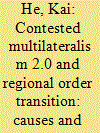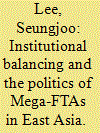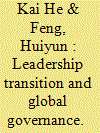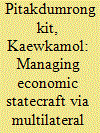|
|
|
Sort Order |
|
|
|
Items / Page
|
|
|
|
|
|
|
| Srl | Item |
| 1 |
ID:
187400


|
|
|
|
|
| Summary/Abstract |
Challenging a popular view that China’s rise will lead the United States and China to fall into the ‘Thucydides trap’—a possible hegemonic war between the two—this paper proposes an ‘institutional peace’ argument, suggesting that the ongoing international order transition will be different from previous order transitions in history. Instead of using military means to change the international order, China and the United States have relied on various institutional balancing strategies to compete with one another for an advantageous position in the future international order. The discussion on the institutional competition between China and the US around the AIIB and the ARF-related multilateral security architecture supports the ‘institutional peace’ argument: institutional competition in the form of institutional balancing strengthens the dynamics and utility of international institutions, encourages states to offer new public goods, and could lead to a more peaceful order transition in the international system. However, this institutional peace argument is constrained by two caveats: the continued validity of the MAD nuclear deterrence and a limited degree of ideological antagonism between the US and China.
|
|
|
|
|
|
|
|
|
|
|
|
|
|
|
|
| 2 |
ID:
165152


|
|
|
|
|
| Summary/Abstract |
This article proposes a new concept of ‘contested multilateralism 2.0’ to describe the puzzling institutional building efforts by non-ASEAN members after the 2008 global financial crisis (GFC) in the Asia-Pacific. It suggests that different to ‘multilateralism 1.0’ of the 1990s, which was mainly led by ASEAN, this wave of multilateralism has been initiated by other powers, such as the United States, China, Japan, Australia and South Korea, either by forming new institutions or by reinvigorating existing ones. This article advances an institutional balancing argument. It suggests that ‘contested multilateralism 2.0’ is a result of institutional balancing among major states under the conditions of high strategic uncertainty and high economic interdependence after the GFC. One unintended consequence may be that it could well lead to a more peaceful transformation of the regional order in the Asia-Pacific if regional security hotspots, such as the Korean crisis and the South China Sea dispute, can be managed appropriately.
|
|
|
|
|
|
|
|
|
|
|
|
|
|
|
|
| 3 |
ID:
149056


|
|
|
|
|
| Summary/Abstract |
The dynamics of institutional balancing is the predominant factor prompting East Asian countries to move to mega-FTAs. Rather than seeking mega-FTAs purely on the basis of economic benefits, these countries, particularly major powers, have attempted to form mega-FTAs to counter the target state’s vision of the regional architecture.
|
|
|
|
|
|
|
|
|
|
|
|
|
|
|
|
| 4 |
ID:
167319


|
|
|
|
|
| Summary/Abstract |
The establishment of the Asian Infrastructure Investment Bank (AIIB) signified China’s ‘charm offensive’ towards multilateral institutions and existing global financial governance. If the rise of China is inevitable, what will the future world look like, and what should other countries be prepared for? Borrowing insights from institutional balancing theory and role theory in foreign policy analysis, this project introduces a ‘leadership transition’ framework to explain policy dynamics in global governance, with the AIIB as a case study. It suggests that China, the United States, and other countries have employed different types of institutional balancing strategies, i.e. inclusive institutional balancing, exclusive institutional balancing, and inter-institutional balancing, to compete for influence and interest in the process of establishing the AIIB. A state’s role identity as a ‘leader’, a ‘challenger’, or a ‘follower’ will shape its policy choices in global governance regarding different institutional balancing strategies in the process of ‘leadership transition.’ Institutional balancing is a new type of balancing among states in the future transformation of global governance. China’s institutional rise in global governance, therefore, might be more peaceful than widely predicted.
|
|
|
|
|
|
|
|
|
|
|
|
|
|
|
|
| 5 |
ID:
192164


|
|
|
|
|
| Summary/Abstract |
Economic statecraft (ES) has been playing an increased role in affecting the international relations. While armed conflicts decline, states have been weaponising trade, investment, and other economic ties to gain leverage over their counterparts. In the contemporary world, ES is not only used to galvanise countries’ influence in specific issue areas but also part of their grand strategy to achieve broad power-maximisation goals. Despite a proliferation of ES literatures in recent years, extant research tended to focus on great powers’ ES, leaving small states’ ES under-examined. Also, previous studies usually looked into how countries unilaterally employ ES. Hence, insufficient attention has been paid to how regional states work together to collectively alter multilateral frameworks to advance their ES. Against this backdrop, this paper investigates small nations’ roles in the development of multilateral cooperative frameworks. Using the ES lens, it explores how these countries leverage these schemes to push forward their collective ES. The main argument is that regional states worked together to craft the terms of multilateral economic agreements to galvanise their clout over certain governance areas. I validate this argument by using the case of Regional Comprehensive Economic Partnership (RCEP). This study makes contributions to the research pertaining to ES, small states’ strategies, and economic regionalism. It also yields practical implications for policymakers involved in fostering international economic governance.
|
|
|
|
|
|
|
|
|
|
|
|
|
|
|
|
| 6 |
ID:
160610


|
|
|
|
|
| Summary/Abstract |
This paper examines the three faces of the Indo-Pacific from an IR theory perspective. It suggests that the realist face of the Indo-Pacific is a “balancing strategy” against China. The liberal face of the Indo-Pacific aims to form a new “institutional setting” that facilitates cooperation among states across the Pacific and the Indian Oceans. According to constructivism, the Indo-Pacific offers an “ideational construct” for promoting value-oriented and norm-based diplomacy in the region. This paper argues that these three faces of the Indo-Pacific concept are theoretically problematic and practically flawed. There are two ways of institutionalizing the Indo-Pacific, though. One is exclusive institutionalization with China as an outside target, which follows the realist logic of making China a common threat in the region. The success of this approach mainly depends on how China behaves in the future. The other is the inclusive approach of institutionalizing the Indo-Pacific by embracing China and other states into a new Indo-Pacific institution. It will not be easy, but the endeavor of the inclusive institutionalization of the Indo-Pacific will produce positive externalities of peace and stability to the region.
|
|
|
|
|
|
|
|
|
|
|
|
|
|
|
|
|
|
|
|
|